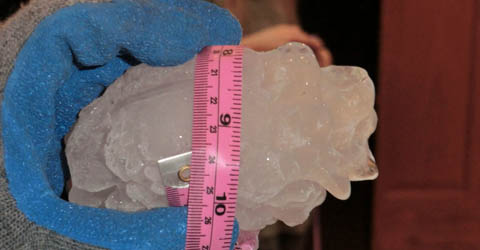A new record for the largest hailstone recorded in Colorado was set during a thunderstorm on August 8th! The record-setting hailstone was measured at 5.25 inches long on the day it fell and weighed in at more than 7 ounces. It was found in the Eastern Plains near Kirk, Colorado. This hailstone broke the previous 4.83-inch record, set in 2019 near Bethune, Colorado.

While we don’t see record-setting hailstones during each storm, Colorado’s Front Range and Eastern Plains regions see quite a bit of hail during the summer months. The Colorado Climate Center, housed in Colorado State University, studies and provides information about these severe weather events. Their website hosts several interactive maps that invite visitors to explore weather information and trends, including maps showing the frequency of large hail around the state. The State Records map offers a quick glance at record-holding extreme weather, including the biggest hailstone, high and low temperatures, and deepest snowfall. The Severe Weather Reports map shows instances of severe hail, wind, and tornados from 1955 to the present, showing a clear pattern that large hail tends to be concentrated in the eastern half of Colorado. Along with severe weather data, the Colorado Climate Center website is a trove of information about Colorado’s typical climate as well as drought, wildfire, and historical weather events.
Climate scientists have been studying hail in Colorado for decades, and several of their historical reports are available in our digital repository:
- Analysis of synoptic data for selected hail days in northeastern Colorado, 1961 presents a general summary of weather conditions that led to hail over the course of one year. This report contains many tables and maps showing the weather trends affecting eastern Colorado.
- Analysis of hailstones (1962) provides insight into how hailstones were studied and analyzed at the time. The authors describe how they collected random samples of hailstones using a funnel and mini-refrigerator to keep the hailstones cool until they could be collected in person. They would then bring the hailstones into a lab to cut cross-sections using a hot wire, take several different measurements, and photograph the hailstones (which was a complicated process, because the hail kept melting during the photography sessions).
- Analysis on hailfalls as background for the design of an experiment in hail modification (1963) uses the data gathered in the report above to inform a potential weather modification project to suppress severe hail in the high plains. Colorado has been a hot spot for weather modification projects like cloud seeding due to our severe weather and the importance of our snowpack to states downstream of the Colorado River.
Current information from the Colorado Climate Center and historical hail studies provide a wealth of knowledge for understanding the complex weather conditions that lead to severe hail. This information can help meteorologists to better predict large hail occurrences, ultimately reducing the risk of injuries and damage from hailstorms.
- Colorado’s Governors: Ralph L. Carr - July 11, 2025
- Celebrating Colorado’s immigrant heritage - June 27, 2025
- Colorado’s Scenic and Historic Byways: Guanella Pass - June 6, 2025